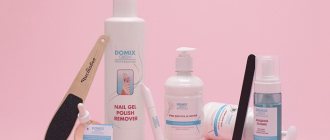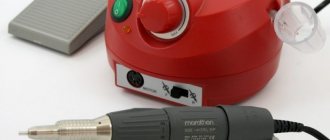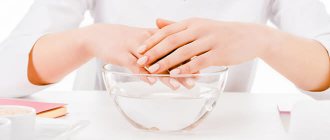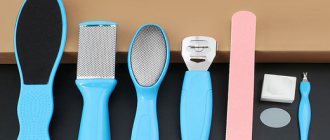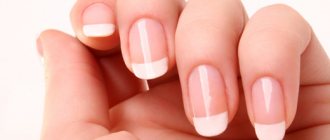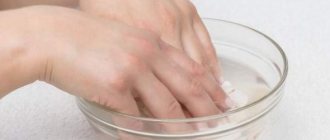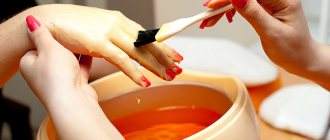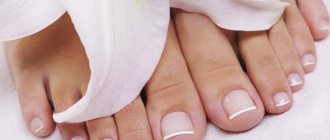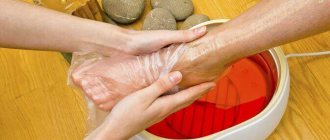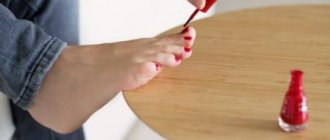Varieties
The desire to achieve a certain result determines the choice of a foot bath solution recipe. The action from the procedure can be:
- relaxing, helping with fatigue after a long day;
- tonic to activate metabolic processes in cells;
- cleansing foot baths for corns;
- medicinal to eliminate local manifestations of the disease or as an auxiliary method of therapeutic action;
- hardening to increase immunity and resistance to diseases.
A lasting positive effect will occur only if the activities are carried out systematically. Daily foot care sessions will become one of your good habits.
It must be remembered that after completing the procedure, it is important to wipe your feet dry and lubricate the skin with a moisturizer, which will prevent dryness and the formation of keratinized layers on the soles of the feet.
Bath oils
Feel free to add different oils:
- castor;
- lavender;
- olive;
- orange;
- almond;
- pink;
- fir;
- tea tree.
Oils are often used to nourish and prevent flaking of the skin.
During colds, foot baths with mustard are used.
They are used:
- for colds;
- when coughing;
- from a runny nose;
- from weakness.
However, using mustard baths during elevated temperatures and inflammation is strictly prohibited!
Healthy soda
Sodium bicarbonate is an affordable product to support beautiful feet. The softening and exfoliating property is used to cleanse the skin of the feet using the principle of a scrub. Getting on the surface of the sole of the lower extremities, soda penetrates into the rough areas and rejects them until healthy cells appear.
After the procedure, necrotic cells are easily removed by gentle cleaning with volcanic pumice or special devices.
Sodium bicarbonate eliminates unpleasant odors. When applied to the skin of the feet, the natural deodorant neutralizes extraneous odors, leaving a pleasant smell of cleanliness.
In addition, soda will remove residual sweat from the surface of the skin, regulating the functioning of the sebaceous glands. A foot bath with soda will remove impurities and dead cells, which is widely used by cosmetologists before cosmetic procedures.
Soda foot baths are taken warm; there is no need to keep your feet at an uncomfortable hot temperature. The therapeutic effect will come faster if the procedure is enjoyable.
To carry out the manipulation, you will need four liters of water and for each liter you will need fifteen grams of soda.
Fill a basin with clean water for the bath and add the required amount of soda and stir. Lower your feet and enjoy the pleasant effect of the procedure for about fifteen minutes, then rub with pumice and rinse with water.
From fatigue
After a hard day, a foot bath will help improve blood circulation. Depending on the components used, you can combine the relief of fatigue with the prevention of fungus or moisturizing the skin of the feet.
Contrasting
- Prepare two containers - one with hot water, the other with cold. A warm bath should be 38-40 degrees, a cold bath – 20-22.
- Immerse your feet in the hot bath for 15-20 seconds, then move them to the cold one;
- Repeat the manipulation 15-20 times. Be sure to finish with a cold bath.
Hydrogen peroxide
A foot bath with hydrogen peroxide will provide not only a cosmetic effect, but also a therapeutic effect. Hydrogen peroxide is used in medical practice as an excellent disinfectant.
When interacting with the skin of the feet, pathogenic microorganisms and fungus will be combated. Therapeutic baths can be carried out as a precautionary measure to prevent germs from penetrating the skin of the feet.
Making foot baths with hydrogen peroxide at home is necessary to cleanse and brighten the skin. After several sessions of interaction with hydrogen peroxide, the heels will become smooth, minor cracking will gradually disappear, and the skin color will become natural, which is especially attractive when wearing open summer shoes.
A foot bath with hydrogen peroxide will prevent excessive sweating due to its drying effect. Getting rid of corns on your feet plays an important role not only in terms of beauty; numerous layers of rough skin can cause the appearance of fungus or the addition of pustular infections.
The recipe for the procedure is simple:
- pour three liters of non-hot water;
- pour in three hundred milliliters of hydrogen peroxide solution, which can be bought without a doctor’s prescription;
- lower your legs for ten minutes.
After the foot procedure, clean the skin of the feet, lubricate with baby cream and put on socks made of natural fabric at night.
Recipes
For preparation, they usually use time-tested recipes that give excellent results.
The main components are:
- salt;
- soap;
- soda;
- ammonia;
- infusions based on medicinal herbs;
- essential oils.
Health difficulties can arise in both cold and warm seasons. In winter, feet get tired from heavy shoes made from artificial materials that are not breathable. In rainy weather, boots can get wet; in autumn and spring, women usually prefer shoes with heels. In summer, dust has an adverse effect on your feet, the skin on your heels becomes rougher, and corns and “spurs” form.
There are many useful recipes, each of which is intended for a specific occasion. For example, a foot bath with hydrogen peroxide is perfect for getting rid of fungus, calluses, and cracks. The solution perfectly brightens, softens the skin, making it unusually smooth. Peroxide cleanses feet very well from cosmetic defects. A positive result can be noticed after the first procedure.
Anti fungus
Baths for the treatment of fungus (onychomycosis), which can easily become infected in a bathhouse or swimming pool, give excellent results during the initial stage of development. In this case, the epidermis of the foot is affected, and then onychomycosis moves to the nails.
Baths should be done daily before bed. It is necessary to use only boiled water, the optimal temperature of which is from 40 to 45 °C. The duration of this process should not be less than 15 minutes.
Before you start taking a bath, you need to pre-treat your feet - rinse well with laundry soap. In case of infection with foot fungus, it is advisable to get rid of keratinized skin affected by microorganisms before the procedure. You can use pumice or sandpaper, be sure to disinfect the first after use, and simply throw away the second.
If the nail plates are infected with fungus, they must be treated before using the bath. First, cut off the overgrown edges of the nails, then clean their surface from white plaque. After finishing the procedure, wipe your feet dry with a towel and lubricate them with the drug prescribed by the doctor.
The most popular ways to get rid of fungal diseases are the following:
- Herbal infusions. Leaves of wormwood, plantain, yarrow, burdock are taken in equal parts and filled with boiling water.
- Decoction of celandine. Helps get rid of fungus on both skin and nails. The herb in the amount of four large spoons is poured into a liter of water, brought to a boil and cooked for another five minutes. Baths should be done for 20 days without a break.
- Treatment with vinegar. The fungus quickly dies in an acidic environment, so if it affects nails and skin, vinegar is used. Suitable for both table and apple. You must strictly adhere to the recipe so as not to get a chemical burn: for the bath you will need to dilute one hundred milliliters of 9 percent vinegar in two liters of water. Keep your feet in the solution for at least 20 minutes.
- Soda solution. Helps successfully fight fungal diseases due to its antiseptic properties, as well as the ability to soften and disinfect the skin. To prepare the bath, you will need to stir baking soda in a bowl of warm water in a ratio of 1 tbsp. spoon per liter of liquid.
- Hydrogen peroxide. In a basin filled 1/3 with water (2 l), add 4 tbsp. spoons of peroxide and the same amount of 9 percent vinegar. The feet are immersed in the solution for 15 minutes. Then the feet are treated with pumice. The procedure should be carried out 2 times a week for 30 days.
Against unpleasant odor and sweating
The problem of sweating feet and the resulting unpleasant odor occurs in many people. This is usually due to poor hygiene, various diseases and frequent wearing of closed, non-breathable shoes.
The following recipes will help you get rid of active sweating:
- Treatments with sage essential oil. For a bath you will need eight to ten drops of this solution. An alternative to this oil can be extracts of bergamot or rosemary.
- Oak bark, horsetail and chamomile brewed with boiling water. Helps eliminate sweating.
- Composition of salt, cinnamon and herbal infusion. Dried wormwood, pine needles and chamomile are mixed, poured with boiling water and infused for one hour. Then the resulting solution is poured into a bath, where Art. lie salt and tea lie cinnamon.
- Chamomile infusion. It is prepared by steaming forty grams of plant flowers. After half an hour, the infusion is poured into a basin and diluted with water to the desired temperature.
Also good for sweating and odor: bay leaves, birch buds and lemon juice.
For fatigue and swelling
Tired legs are often accompanied by swelling. If this is not associated with any serious disease, then the problem can be easily solved with the help of baths. Such procedures have a relaxing effect, help eliminate pain in the limbs and remove toxic substances from the body.
Useful recipes:
- Linden infusion with salt. To prepare it, pour linden blossom with boiling water and leave for at least 30 minutes. Then the infusion is filtered and mixed with hot water and a tablespoon of salt. While using this bath, it is recommended to massage your feet.
- Chamomile infusion and honey. Two tbsp. spoons of flowers are brewed with a liter of boiling water, left for 20 minutes and added to a bowl of water along with a tablespoon of honey.
- A decoction of mint and nettle. The herbs are taken in equal parts (1 tablespoon each) and poured with a liter of boiling water, left for ten minutes, after which the prepared solution is added to the basin.
- Brewed lemon and orange zest. One glass of crushed citrus peel is poured into two liters of boiling water and boiled. The infusion is allowed to cool and poured into a basin.
For cracked heels
The appearance of cracks on the heels indicates that the skin is too dry. To get rid of the problem, you need to steam the areas of the feet with rough skin and remove it.
Recipes:
- A decoction of dried St. John's wort and vinegar. A large spoon of medicinal herb is poured into two glasses of boiling water and left for 10 minutes. Add two tbsp to the cooled mixture. spoons of vinegar.
- Potato peel infusion. In this case, the peel is boiled in two liters of water, after which the liquid is drained and filtered using a sieve. When the broth has cooled to optimal condition, it is used for baths. After completing the procedure, the heels are treated with pumice.
- Corn or potato starch. One tbsp. A spoonful of this product is mixed in a liter of heated water. The feet are usually kept in this solution for at least 15 minutes, then clean warm water is gradually added.
- Hydrogen peroxide. A traditional bath is made with the addition of soda and peroxide, and then the feet are lubricated with glycerin.
From numbness
The causes of numbness in the legs are uncomfortable sitting position and wearing tight shoes. If the problem is not related to serious diseases of the spine or diabetes, then it can be solved by taking baths. These procedures help restore impaired blood circulation.
Recipes for cooking:
- A large spoonful of salt, 10 g of camphor alcohol and 50 g of ammonia (10%) dissolve in a liter of liquid. The composition is mixed and used for baths. The procedure is carried out within ten minutes.
- Add one tbsp to a container with two liters of liquid. spoon baking soda, sea salt and dry mustard. The feet are lowered into the thoroughly mixed solution. The duration of the procedure is at least thirty minutes.
For calluses and corns
Rough skin on the feet and the formation of blisters is a fairly common problem, especially in the summer. This is due to open-type shoes that are not always comfortable and can be eliminated through baths.
Products with the following components are used:
- Composition of ammonia and sea salt. Two tbsp. spoons of each component are dissolved in a liter of warm liquid. Keep your feet in the resulting saline solution for about 15 minutes.
- Soda, liquid soap, ammonia. One tablespoon of each element is added to 2 liters of warm water. The duration of the soda bath procedure is half an hour.
- Boric acid. This antiseptic is used in the amount of fifty milliliters per half liter of water. After completing the procedure, wipe your feet dry and lubricate them with Vaseline.
To soften rough skin
Dry and rough skin on the feet indicates dehydration, heavy loads and lack of care. In addition to the unattractive appearance, this pathology is accompanied by unpleasant sensations and inconveniences. Foot baths are ideal to increase skin elasticity and soften it.
The most effective procedures are considered to be the following:
- Two tablespoons of green tea are brewed in ½ liter of boiling water, after 10 minutes the infusion is poured into a container for procedures. The bath time is 20 minutes.
- Half a liter of milk is added to two liters of warm water.
- Two and a half liters of water are poured into the container, then a glass (200 grams) of white clay (sold at the pharmacy) is added. You can add two tablespoons of olive oil to the composition.
- Two or three aspirin tablets are dissolved in hot water. The feet should be in this solution for at least thirty minutes.
- 6 tsp. spoons of soda and 2 tbsp. spoons of crushed soap are dissolved in 2.5 liters of warm water. Feet should be kept in this solution for 15 minutes.
For joint diseases
The cause of pain in the joints is the increased content of uric acid salts in them, which gradually leads to inflammation and tissue modification. Such diseases require immediate medical attention. In order to prevent and prevent exacerbations, you can use foot baths.
Instructions:
- One tbsp is dissolved in three liters of hot water. a spoonful of soda and nine drops of iodine. After these two substances enter into a chemical reaction with each other, forming foam, the treatment procedure should begin.
- 4 large spoons of salt are dissolved in two liters of water, and 20 drops of iodine are poured in.
- Dried chamomile flowers are brewed in five liters of boiling water, then 100 g of salt and 1 teaspoon are added to the infusion. spoon of iodine.
Contrasting
Contrast foot baths have a positive effect on the body. In addition to hardening, these procedures train blood vessels and are useful for the initial stages of varicose veins.
To carry out the treatment, it is necessary to place two containers with water next to each other, pour liquid heated to 40–45 °C into one, and to 20–22 °C into the other. First immerse your feet in hot water and leave them in it for one minute, then move them to a bowl of cold water for a few seconds. You should move from one container to another several times, and finish the procedure in a hot liquid.
Strengthening
The procedures are recommended to be carried out in order to increase immunity during the cold season. Thanks to them, the body's resistance to viral diseases increases.
To carry out the procedure, 200 g of flax are brewed in 300 ml of boiling water. The composition is infused for several minutes and poured into a basin with three liters of hot liquid. Then steam your feet for 20 minutes.
Healing iodine
A nail bath with iodine is suitable for those who are concerned about the condition of their toenails. Thin, brittle, split nails look painful and unsightly. Damage to the nails can be caused by poor care, low-quality shoes made of artificial materials, as well as diseases of the internal organs.
A nail bath with iodine can be a therapeutic procedure that will restore your nails to health. The natural chemical element contained in sea water will provide the nail tissue with the missing elements for restoration.
Iodine is an inexpensive solution that can be purchased at a pharmacy. It is not recommended to lubricate the nail with pure iodine; instead of a therapeutic effect, you can get a burn and destruction of the surface layers of the nail plate. Therefore, iodine must be diluted with water for foot baths to dilute it with enough water.
Nail bath with iodine: preparation method:
- pour olive oil into a small container;
- drop three drops of iodine and five drops of liquid retinol;
- combine and place the feet in the oil-iodine mixture so that the nails are completely covered with the healing solution;
- exposure time up to twenty minutes.
A nail bath with salt and iodine is often used in cosmetology practice. The healing composition contains water heated to forty degrees, four drops of iodine and fifteen grams of table salt. Stir the solution and make nail baths with salt and iodine for strong and healthy nails.
Functions of whirlpool baths
The main goal of pedicure baths is relaxation. This effect is achieved due to the optimal water temperature and various additives. Most often, sea salt and essential oils are added to the liquid, which enhance the effect.
Steaming the skin is not the only function of pedicure baths.
Such devices have many additional options, the main ones being:
- Classic hydromassage . Most models of foot baths are equipped with a relief bottom. During classical processing (using water), it vibrates slightly. This helps eliminate fatigue.
- Jacuzzi . Soft streams of water act chaotically on the skin, treating various points on the feet. This mode refers to SPA procedures and gives maximum relaxation.
- Dry massage . In this case, the skin of the feet is treated not by streams of water, but by vibrations generated on the embossed surface of the bottom. This massage is less pleasant, but quite effective when there is no time for steaming.
- Infrared rays . To prevent or treat varicose veins, a mode of infrared rays is used, which penetrate into the deep layers of the dermis and instantly increase blood flow.
Switching between modes is carried out using a standard switch located on the device body, or via a remote control. For each option, it is possible to set a timer - the device automatically stops the task after the set time has passed. Some bath models are equipped with a power regulator (relax, turbo), which helps to adjust the mode as efficiently as possible.
Hot tub modes
Baths intended for professional use are equipped with additional pedicure attachments. Most often they are presented in the form of pumice, brush and splash pad. You can purchase additional attachments depending on your individual preferences and work characteristics. For home use, additional elements may not be required at all.
The benefits of salt
Salt foot baths are known from the distant past, when the beneficial properties of salt were proven through many years of experience. Improves local blood circulation, gets rid of sweat and fat, an excellent whitening and exfoliating agent.
In addition, salt is a real storehouse of microelements; it contains silicon, potassium, and iron. If possible, it is preferable to take coarse sea salt; it will be much healthier than table salt.
Salt foot baths help relieve fatigue, relieving tension and having a relaxing effect. Increased blood flow improves metabolic processes and tissue regeneration. Irregularities, roughness, and cracks in the feet disappear when the procedure is carried out correctly.
Salt baths at home are useful not only for the skin, but also for the beauty of nails. Microelements contained in salt solutions strengthen nails, making them smooth and hard.
A sea salt nail bath will give amazing results if used regularly.
Salt foot baths have the following composition:
- four liters of water;
- thirty grams of salt.
The hypertonic solution should be warm; it can also be poured into a bath for sweaty feet. After a fifteen-minute session, it is important to wash your feet so that any remaining salt does not cause irritation.
A nail bath with sea salt should be carried out after preliminary cleansing of dirt and decorative coating from the nails for better permeability of the treatment solution.
Dissolve a pinch of sea salt without additives in water and leave your feet for ten minutes. After time, each finger can be lubricated with a mixture of olive oil and a few drops of liquid vitamin A.
Rules for taking a foot bath
Before you start cooking, carefully study all the rules, and also read the list of contraindications. Even at home you can cause harm to the skin and the body as a whole, so do not neglect a few tips:
- The water temperature should not be too high and exceed 50 degrees - boiling water reduces the elasticity of the skin and causes discomfort.
- After the procedure, it is not recommended to go outside for 3-4 hours, especially in winter. The body will react to the temperature difference and launch accelerated regeneration, which will negate all the benefits;
- After the bath, put on warm socks, after lubricating your feet with cream to enhance the effect;
- Conduct a session an hour before meals or 30 minutes after, so as not to overload the body;
- The liquid in the bath should completely cover the foot. If the container for the procedure is too wide, double or triple the amount of ingredients indicated in the recipes below.
Strengthening Vinegar
Apple cider vinegar foot baths are one of the healing treatments that are beneficial for the feet. Vinegar is famous for its tonic effect on the skin. In addition, this chemical compound includes trace elements necessary for the synthesis of new cells, but also vitamins and enzymes.
The nutritional properties of vinegar strengthen not only the legs, but also the capillaries located close to the surface of the skin.
Foot baths for varicose veins are prescribed exclusively with vinegar. The disinfectant effect on the feet disinfects the surface and has a detrimental effect on the fungus. A nail plate affected by a fungal infection grows back with healthy cells. The smell of sweat is neutralized, and the sweat glands do not produce large amounts of exudate.
Foot baths with apple cider vinegar follow several recipes:
- Water is taken into a small basin, approximately 40 degrees, two hundred milliliters of vinegar and the same amount of salt are added. Stir quickly and immerse your feet for a quarter of an hour. Favorite essential oils will make the procedure especially pleasant.
- For foot odor, the following recipe is suitable: combine three liters of water with a liter of apple cider vinegar and one glass of soda. Keep your legs for no more than ten minutes; if any unpleasant sensations appear, you must stop the procedure ahead of schedule.
- For fungal infections, take half a liter of fresh honey and add one hundred milliliters of vinegar. The feet are immersed in the honey mixture and kept for twenty minutes so that the affected areas are hidden in the composition.
How to make foot baths?
It would seem, what features might there be in such a home cosmetology procedure - I put my feet in the water (a basin or a special hydromassage bath), added care components and that’s it.
However, there are basic rules that can help you enhance the expected result and minimize the occurrence of side effects. These rules are based on the postulates of balneology - an officially recognized method of therapeutic treatment with mineral waters.
- Water temperature
The water should be moderately hot. Consider the individual characteristics of your skin. Some people can easily tolerate water at 40 degrees, while others can get burned in it. Try to maintain a comfortable temperature throughout the procedure.
- Water volume
The optimal volume is 3-5 liters. In this case, the water should completely cover the feet and reach the ankle, capturing the Achilles tendon. It is not recommended to warm the legs above (up to the knees), as this can often be unsafe for health.
- Time spending
It is important not only to observe the recommended duration of foot baths, but also the time of day. This way your legs are less stressed in the evening. If you can then take a horizontal position, this will enhance the metabolic processes in the skin of the feet, activated by the water procedure.
As for the time for the procedure, 15–20 minutes is enough, after which the water will cool down completely.
The regularity of baths at home is no more than 3 times a week. The already familiar rule is that the main thing is not to overdo it.
- Dryness is the key to health
Probably the most important aspect of home foot baths, often ignored, is the obligatory drying of the feet. Remember that raw steamed feet are a golden breeding ground for bacteria. Never forget to take a towel before putting your feet in the bath.
Rules for home foot baths
So,
- first - prepare a bath with hot water according to the recipe, immediately take a towel, pumice stone, cream and socks;
- second - mark the time, there is no need to sit out;
- third - taking your feet out of the water, dry them thoroughly with a towel, then remove the stratum corneum with a pumice stone, rinse, dry and rub the cream until completely absorbed, massage your feet and only then put on your socks.
By the way, after, as already mentioned, it is best to lie down and raise your legs slightly above body level, placing a pillow under them. Half an hour is enough for the procedure to be considered completely completed.
Healing aspirin
Water treatments for feet with aspirin give excellent results for cleansing rough skin on the feet. Neglected corns will disappear with constant use of the recipe with acetylsalicylic acid.
The chemical properties of the drug have a powerful softening effect on the skin. Dead cells swell in hot water and are sloughed off, releasing healthy skin.
When the desired result is achieved, baths using aspirin continue to be done for prophylactic purposes.
For a healing session, you need to prepare four aspirin tablets and a basin of hot water. To make the tablets dissolve better, it is better to crush and crush them. Pour into the water, lower your legs and remain in a relaxed state for another thirty minutes.
In addition to combating pathological skin deposits, the product is used to disinfect feet and prevent the appearance of unpleasant odor.
How to take it correctly
To increase the effectiveness of foot baths, you should take into account some of the nuances of their preparation and use.
The following recommendations must be followed:
- Selecting water temperature. Depends on the purpose of the procedure. Baths designed to soften the skin, followed by a pedicure, removing calluses and hangnails, involve the use of hot water, while medicinal ones use warm water.
- Amount of water. For events you will need 3-5 liters of liquid. It is recommended to immerse your feet in the water up to the ankles; diving deeper can have a negative impact on your general condition.
- Duration of the procedure. In order to thoroughly soften the skin and provide the opportunity for substances dissolved in water to exert their beneficial effects, fifteen minutes is enough. It should be borne in mind that long-term exposure of feet to hot water is harmful to health.
- Constituent substances. When adding additives to water, they should not be abused. Even the most common salt can dry out the skin, thereby injuring it.
After completing the procedure, it is necessary to treat the feet with pumice. Then wipe your feet dry and lubricate with rich cream, then put on socks.
If the skin on the feet is too rough, you should first treat it with lemon juice before performing an event with a bath. To do this, the fruit is cut into slices, which are applied to problem areas and fixed.
The compress should be kept for at least 20 minutes. Lemon acid will help soften dead skin, and its natural origin will make it safer, unlike chemicals.
Contraindications
You can do foot baths if there are no contraindications. It is better to consult a doctor first.
Soaring your feet is contraindicated in the following cases:
- Pregnancy, especially in the early stages. Hot baths can pose a risk of miscarriage.
- High blood pressure. In this case, the exception is procedures using mustard, which has the ability to normalize the functioning of the kidneys, heart and blood vessels. The water in such baths should not be made hot.
- Damage to the skin of the feet, for example, burns, cuts, frostbite.
- The presence of tumors of various origins, including oncology, as well as other pathologies.
- Heat.
- Varicose veins, thrombosis.
- Skin diseases: dermatitis, urticaria and others.
Gentle glycerin
A caring foot bath with glycerin has a softening and wound-healing effect. This unique product is a moisturizer for rough and dry heels. The structure of glycerin is able to retain moisture on the skin, making it soft and attractive.
In addition, the product helps with deep painful cracks, which are sometimes accompanied by severe pain. After a few uses, improved results will become noticeable. The healing effect, accompanied by an antibacterial effect, will help restore the skin of the feet.
A foot bath with glycerin is taken as follows:
- prepare three liters of water so that it is at a low temperature;
- add three teaspoons of glycerin to the container;
- Immerse your feet for a quarter of an hour.
Foot baths are of great benefit for getting rid of dermatological problems and treating diseases of the lower extremities. The therapeutic procedure is recommended to be performed for preventive purposes.
Tags: Epsom salts, aspirin, baths, glycerin, iodine, hydrogen peroxide, baking soda, heels, salt baths, vinegar, care About the author: Andrey Stepanovich
« Previous entry
Why use foot baths?
Each of us, having spent the whole day on the move, dreams of being at home in the evening to take off our shoes, relax our legs, stretch them out on a couch, ottoman, or armchair. We dream of just relaxing!
And what could be better than preparing foot baths at home, taking your time, immersing your feet in hot water and washing away the day's painful fatigue. It's very easy to prepare! There are a huge number of ingredients to help you heal and relieve fatigue.
Why are they useful:
- Disinfect;
- Deodorize;
- Harden the skin and body;
- Have an astringent effect;
- Improve blood flow;
- Tones the skin;
- Relieves swelling;
- Increase elasticity;
- Relax;
- Nourishes the skin of the feet;
- Cures fungus;
- Exfoliate dead cells;
- Relieves inflammation;
- Heal the skin;
- Remove corns and cracks;
- Heals calluses;
- Recommended for gout;
- Normalize metabolism.
Foot baths with sea salt help eliminate the smell of sweat for a long time, improve skin condition, kill germs and bacteria. Ordinary soda also copes with the smell of sweat. But herbs always occupy a special place.
Herbs:
- series;
- tansy;
- centaury;
- plantain;
- thyme;
- wild rosemary;
- burdock;
- elder;
- chamomile;
- St. John's wort;
- Melissa;
- birch;
- lilac;
- sage;
- calendula.
Herbal baths have many positive qualities. With their help, you can disinfect your feet, relieve swelling, and eliminate the smell of sweat. Herbs refresh, soften the skin of the feet, relieve itching, pain and save from colds.
Removal with glycerin
There is another method that experts recommend. It gets rid of dry calluses and softens the skin on the entire foot. It can be used as the next step after the bath.
How to do:
Mix 8-10 drops of ammonia with 50 ml of glycerin. Apply this mixture to your feet before going to bed and wear thick socks. 8-10 procedures will be enough to make the skin soft.
A fashionable pedicure is an integral part of well-groomed feet. Find summer design ideas in Joy-pup .
Relaxing foot bath with chamomile at home
Chamomile flowers have anti-inflammatory properties and also moisturize and heal damaged or dry skin. This is a wonderful recipe to relieve stress, pamper and soothe tired feet.
You will need:
- chamomile tea – 6 bags or 2-3 tbsp. l. dry grass;
- lavender essential oil – 5 drops;
- honey 2–3 tbsp. l.
Softening baths
This bath is very easy to make:
- 3 liters of hot water;
- soda 2 tbsp. l.;
- laundry soap 2 tbsp. l.;
- 2 tbsp. l. ammonia. Usage time: 30 minutes.
To get rid of unpleasant rough heels and calluses forever, you need to take a softening bath two or three times a week.
At night it is good to make baths with decoctions of various herbs, for example, chamomile, calendula, nettle. This healing procedure tones and has bactericidal properties. After the session, you need to smear the skin of your feet with a special moisturizer and lie down to rest, wearing cotton socks.
A bath with herbal decoctions has a similar effect. Need to:
- nettle 3 tbsp. l.;
- St. John's wort 3 tbsp. l.;
- 1 liter of boiling water;
- leave for 20 minutes, strain and pour the broth into an already prepared container;
- The duration of the procedure should be 15-20 minutes.
An oatmeal bath will help soften rough skin on the feet:
- 500 ml oatmeal decoction;
- 1 tbsp. l. decoction of pine needles;
- mix all;
- The procedure time is about 15 minutes.
A milk bath will make your feet feel velvety, soft and smooth. You need to pour 1 liter of warm milk into a container with heated water. Leave the feet for 30 minutes, then dry with a towel and wipe the feet with a cotton pad and lemon juice.
The best foot bath recipes
Before you start using the bath, be sure to test the product for an allergic reaction on the crook of your elbow. Components in the form of oils of some herbs are not suitable for everyone. Find out the availability of the product, its availability in the required quantity for the procedure and the main purpose of the bath. The temperature regime and the components of a softening bath will not cure you of colds, and a sweat remedy will not soften calluses.
With soda
Excessive sweating, corns, cracking skin of the feet are a good reason to use a multifunctional soda bath. Cooking process:
- You can dissolve pure soda for the bath.
- Add 1 tablespoon of soda powder to 1 liter of warm water and apply for 20 minutes.
- After this procedure, it is advisable to apply nourishing cream to your feet and put on socks.
By adding a decoction of chamomile, calendula or celandine to such a soda bath, the procedure will help soften the heels and rough skin. It will be easier to conduct a session of treating problem areas of the legs with pumice and a special file after such a soda bath. Calendula and celandine additionally heal small cracks in the skin of the feet.
Paraffin
Paraffin baths for hands and feet are becoming increasingly popular among clients of fashionable beauty salons. With the help of paraffin therapy, you will be able to moisturize, soften the skin, relieve stress, fatigue and strengthen your nails. Good warming of the feet eliminates painful sensations in the joints. The procedure is very simple even for use at home. Frequency of bath use: 1-2 times a week.
To achieve the correct consistency of the product, follow these steps:
- Melt cosmetic paraffin in a water bath until warm. It should not burn the skin.
- While melting the main ingredient, clean the skin of your feet well with lotion and scrub.
- Place your feet in the bath for a maximum of 10 seconds and remove. Repeat the process 5 times until a thick layer of paraffin appears on your feet.
- Put bags and warm socks on your feet and leave for half an hour (all night). After such a good warming bath, the paraffin is removed and cream is applied to the skin.
With mustard
A very highly effective remedy for fighting colds and infectious diseases. The procedure has been familiar since childhood; mothers used mustard powder as soon as a cough or runny nose appeared. A bath with mustard is contraindicated in case of illness for people with high fever. Table mustard is not suitable for such a bath; you will need dry mustard powder.
Cooking process:
- For a bath, take a liter of hot water and add a tablespoon of mustard.
- We dip the feet for a certain time: from 10 to 30 minutes, but as the water cools, you need to add hot liquid to the basin; the feet should not cool down suddenly.
- The mustard powder bath procedure must be carried out daily until the symptoms of the disease go away and the person recovers completely. 1-2 procedures will be required per day.
With sea salt
A bath with sea salt not only relieves physical tension in the legs, but also helps to free oneself from heavy emotional energy, relieve stress and tension. Such sessions for the skin of the legs have healing properties for colds and prophylactic properties for venous diseases. For colds, baths are used every day until recovery, and for weakness and vascular diseases - twice a week.
Multifunctional salt bath recipe:
- For a liter of warm water you need to take a drop of pine oil and a tablespoon of coarse sea salt. Dissolve the ingredients.
- Dip your feet into the liquid and hold for about half an hour.
- As soon as the water cools, add hot water and diluted sea salt to the bath.
With hydrogen peroxide
It is quite possible to restore smoothness, softness and tenderness to your heels without visiting a salon. Ordinary hydrogen peroxide becomes an assistant for the feet in such an important matter. When using the product, the correct proportion is very important so as not to harm the feet. Peroxide baths can be used if the hardening of the heel was not caused by a serious illness.
Cooking process:
- To soften the heels we need: 4 tablespoons of hydrogen peroxide, 1.5 liters of hot water.
- We dilute a weak solution of peroxide in liquid, steam the feet for 5 minutes, remove and clean the softened heels with a pumice stone or a special sanding file.
- When performing the procedure for the first time, it is better to keep your feet in water for 2.5 minutes.
- Peroxide is a caustic product, so baths are allowed no more than twice a week.
From oak bark
You can prepare a safe remedy to combat sweaty feet yourself using oak bark. When performing such a session 1-2 times a week, you will be able to cope with unpleasant pathology and increased sweating. To create a healthy decoction, do the following:
- Take 500 ml of water, a tablespoon of fine oak bark.
- We put the water on the fire, wait until it boils and lower the oak bark.
- Cook for about 7 minutes, cover and leave. Add 200-300 ml of hot water to the finished liquid and place the feet in a basin. When the water begins to cool, we take out our feet and wipe them dry.
Turpentine
The healing properties of a turpentine bath have a beneficial effect not only on the health of the skin of the feet, but also the whole body. Indications for such cosmetology sessions are:
- arthrosis;
- arthritis;
- hypertension;
- viral infections;
- period of treatment after a stroke;
- weakened immunity.
Cooking process:
- The bath is prepared using a special pharmaceutical solution. Add 20 ml of turpentine solution to 3 liters of warm water and mix thoroughly.
- We lower our feet, sit for no more than 10 minutes, after which we wipe our feet dry.
- We put on cotton socks and give our feet a rest.
- Full course of using turpentine baths: 10-20 procedures.

